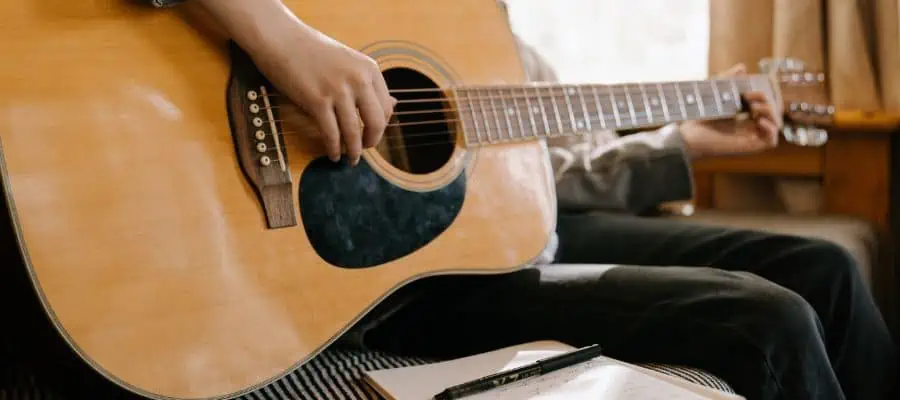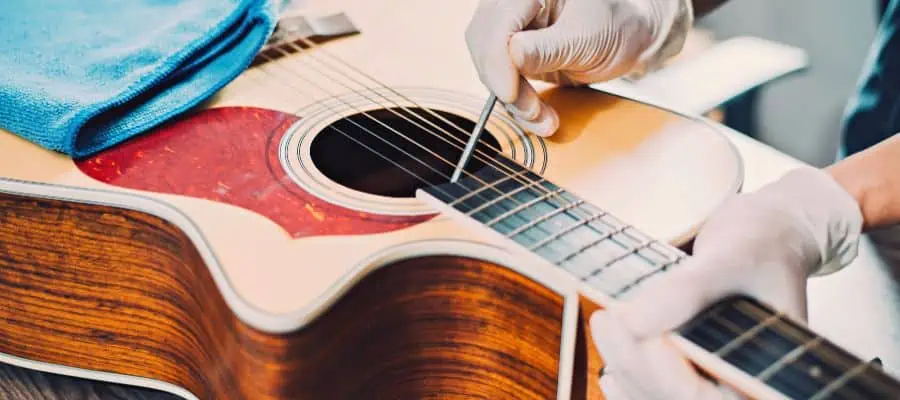If you’ve recently made the switch from electric to acoustic, you might’ve been taken aback by how uncomfortable these guitars can feel. While this experience isn’t always universal, there’s no denying that some acoustic guitars are simply challenging to play comfort-wise, so why is that?
The main reason why some acoustic guitars are more uncomfortable than their electric counterparts is that their strings are thicker and, thus, apply more pressure to your fingers. Their size, shape, neck profile, and overall quality can also contribute to the lack of comfort they provide.
If you’re interested in learning more about the factors that make some acoustic guitars so uncomfortable make sure to read on. Below, I’ve given an in-depth explanation of everything that can affect your comfort level when playing an acoustic guitar. I’ve also provided some fool-proof tips that can help make the experience much more pleasant, so stay tuned until the end.
Factors That Can Make an Acoustic Guitar Uncomfortable
Here are the factors that might be contributing to your acoustic guitar feeling uncomfortable:
Bigger Neck

Generally speaking, acoustic guitars tend to have bigger necks than what most guitarists are used to, making striking certain chords that much trickier. This also means that you’ll have to play around a bit with the positioning of your arm before you find what works for you.
Thicker Strings
As mentioned above, acoustic guitars are usually fitted with thicker strings. Unfortunately, this means that you’ll feel even more pressure and tension against your fingertips, which can make the whole playing experience uncomfortable, especially during those first few tries.
Keep in mind that thicker strings are also held under higher tension, which can further contribute to the pain and discomfort you’re feeling.
Unique Shape and Size

In order to deliver their signature warm sound, acoustic guitars sport a unique shape and size that might feel uncomfortable to some. This is especially true for those who’ve played electric guitars their whole lives and have recently switched to acoustic – the way these instruments feel on your body will take some getting used to.
Quality Level
Not all acoustic guitars are created the same, and some cheaper models never get a proper setup by a shop. That’s why some of them have such uneven frets, poorly finished necks, and other construction issues that it comes as no surprise that they don’t feel comfortable enough.
Electric guitars, on the other hand, are required to undergo far stricter quality checks, which makes it more difficult for manufacturers to cut corners while producing them. Though this means that the price of these instruments will be far higher, it also means that the quality and design will be on par with what you pay, so you’ll rarely have to sacrifice comfort.
How To Make an Acoustic Guitar Feel More Comfortable
If your acoustic guitar feels uncomfortable for any of the reasons outlined above, the good news is that there are some steps you can take to remedy the issue, at least to some extent.
Here are some of my top tips on how to make an acoustic guitar feel more comfortable:
Change the Strings

One of the easiest approaches you can try is to change the strings, which were probably already due for a replacement anyway. This time, though, try to go with a lower-gauge set (so long as it doesn’t affect the overall sound quality), preferably one made with gentler materials that don’t damage the soft tissue of your fingertips too much.
Have the Guitar Set Up by a Professional
If your guitar is on the cheaper end of the price range, chances are it has never seen the inside of a reputable guitar store. So, take it to one to have it professionally set up. An actual technician will adjust the action, intonation, and saddle to optimize sound and playability.
Adjust the Neck Relief
Since the thicker neck is one of the main reasons why acoustic guitars tend to feel uncomfortable, taking some steps to make holding the guitar a bit easier can make a world of difference.
One of the best things you can do is adjust the neck relief, which refers to the amount of bow in a guitar’s neck. When the relief is too high, it can make the instrument unnecessarily uncomfortable to play, so lower it by adjusting the truss rod.
Use a Strap

There’s a reason why you see so many acoustic guitar players using a strap – these instruments can sometimes get too big and bulky for comfort. So, take some of that pressure off your hands (which are struggling to wrap around the thicker neck) .
You’ll be surprised at just how much of the pressure will be alleviated once you implement this simple tip.
Practice Good Posture and Technique
Poor posture can make any playing experience feel uncomfortable, and when you consider the fact that you’re playing with a bigger, oddly-shaped instrument (at least to you) the process becomes unbearable.
So, make a point to sit or stand in a comfortable position while trying to keep a straight back, reducing strain on your hands, and keeping your arms and shoulders relaxed.
As you advance, your improving technique will also help alleviate some of that excessive pressure and friction on your fingers, leading to a much more comfortable playing experience.
Invest in Helpful Accessories
If none of the tips above seem to work for you, you can always go the extra mile and invest in some accessories whose only goal is to make playing your guitar feel more comfortable and effortless. These include (but aren’t limited to):
- Footstools
- Finger picks
- Thumb picks
- Capos
Conclusion
There are several factors that contribute to some acoustic guitars being more uncomfortable than their electric counterparts. These include string thickness and material, size, shape, and neck profile.
That’s why it’s important to test out different guitars until you find one that you actually enjoy playing. However, if you already have a model that’s causing you discomfort, the good news is that there are still a few steps you can take to make the process that much more pleasant.
If you found this article useful, you may want to save this pin below to your Guitar board.

Recent Posts
When learning new songs have you noticed that some of the chord sequences sound really good? But when you tried to come up with your own chord sequence, or as we call it chord progression, you found...
Some guitarists insist on buying an expensive amplifier with their electric guitar. They assume that this is a must for every type of guitarist out there. However, in some situations, this isn’t...

